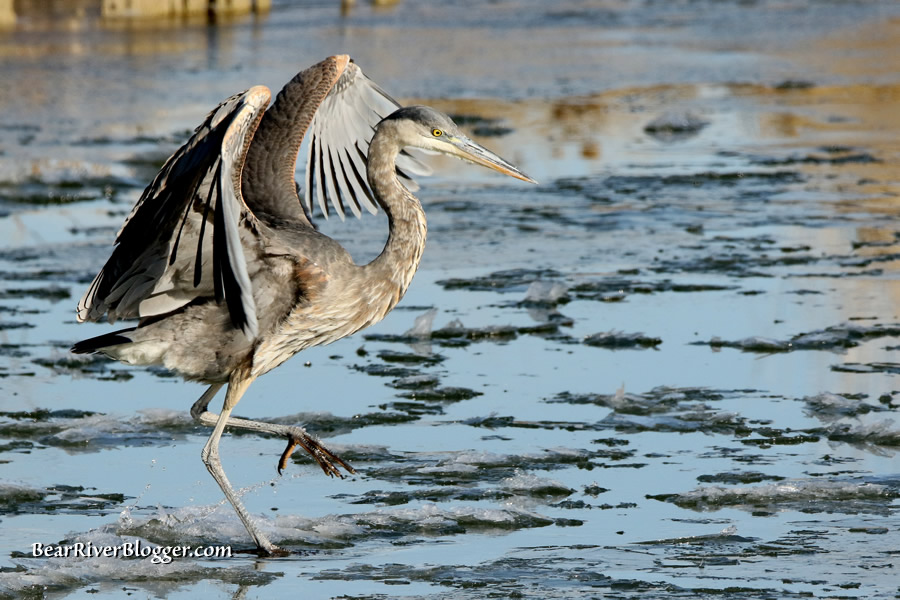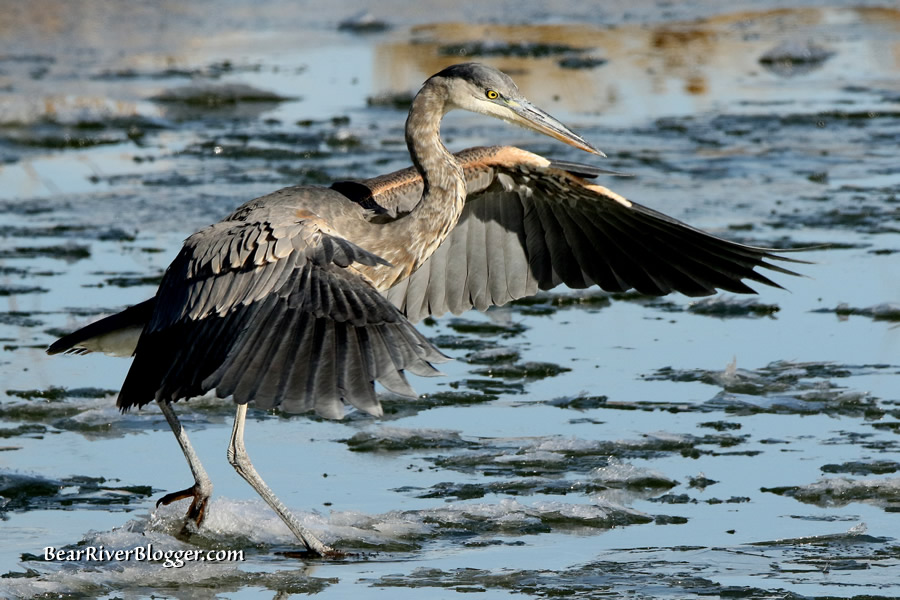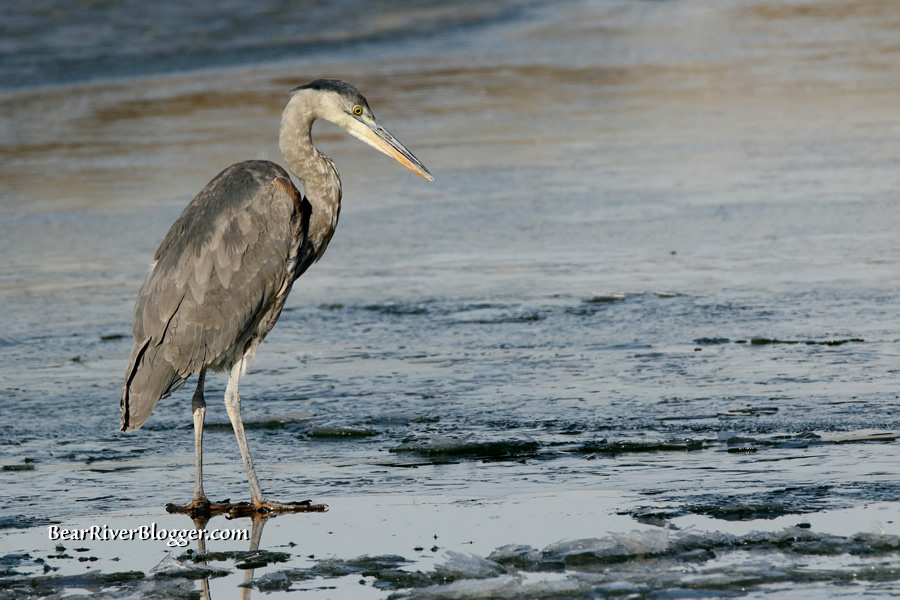Great blue herons offer some unique and interesting opportunities for bird watchers and photographers alike. In many areas, they are found year-round, making them a great bird to watch and photograph during the varying seasons throughout the year. But where is the best place and what is the best season to view and photograph these large wading birds?
In my opinion, winter on the Bear River Migratory Bird Refuge is one of the best times and one of the best places to view and photograph this unique and interesting bird. All of the photographs of great blue herons on this page were taken on the Bear River Refuge this past December, just a few days before Christmas, in fact.
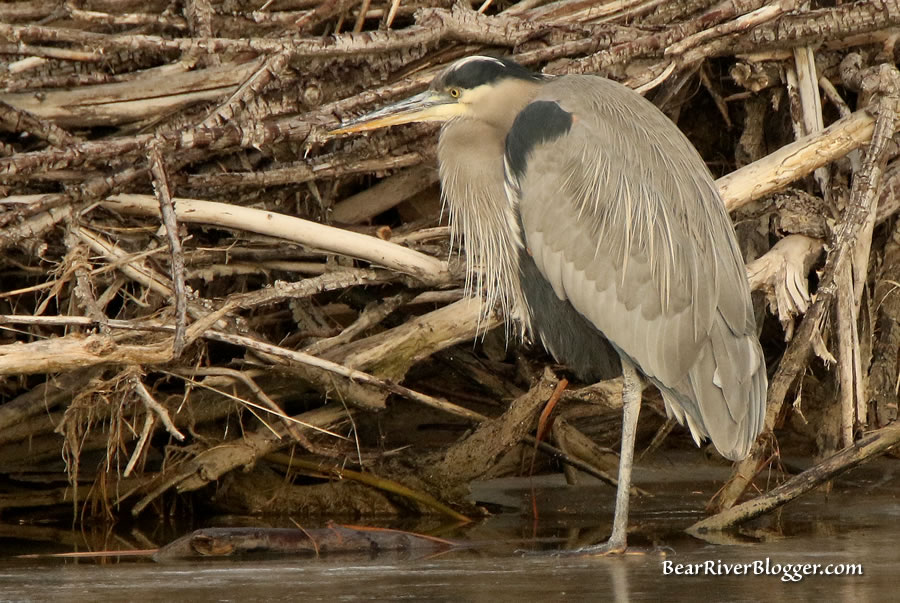
Where do great blue herons live?
Great blue herons are very widespread across North America. They have been known to be as far north as the coastline of southern Alaska and encompass a variety of freshwater habitats such as desert rivers, lakeshores, subtropical mangrove swamps, and freshwater marshes.
If you want to find a great blue heron, all you typically have to do is find a wetland or marsh. They are a wading-bird, meaning they stand in or alongside water to find prey, so the first thing you look for is shallow water.
One of the best places to see a great blue heron is the Bear River Migratory Bird Refuge, located in northern Utah, just west of Brigham City.
It is a nearly 77,000-acre migratory bird refuge managed by the U.S. Fish and Wildlife Service for the benefit of birds and bird enthusiasts of all kinds. On the refuge, you have the opportunity to take a self-guided auto tour route where you can often find herons close by alongside the gravel road.
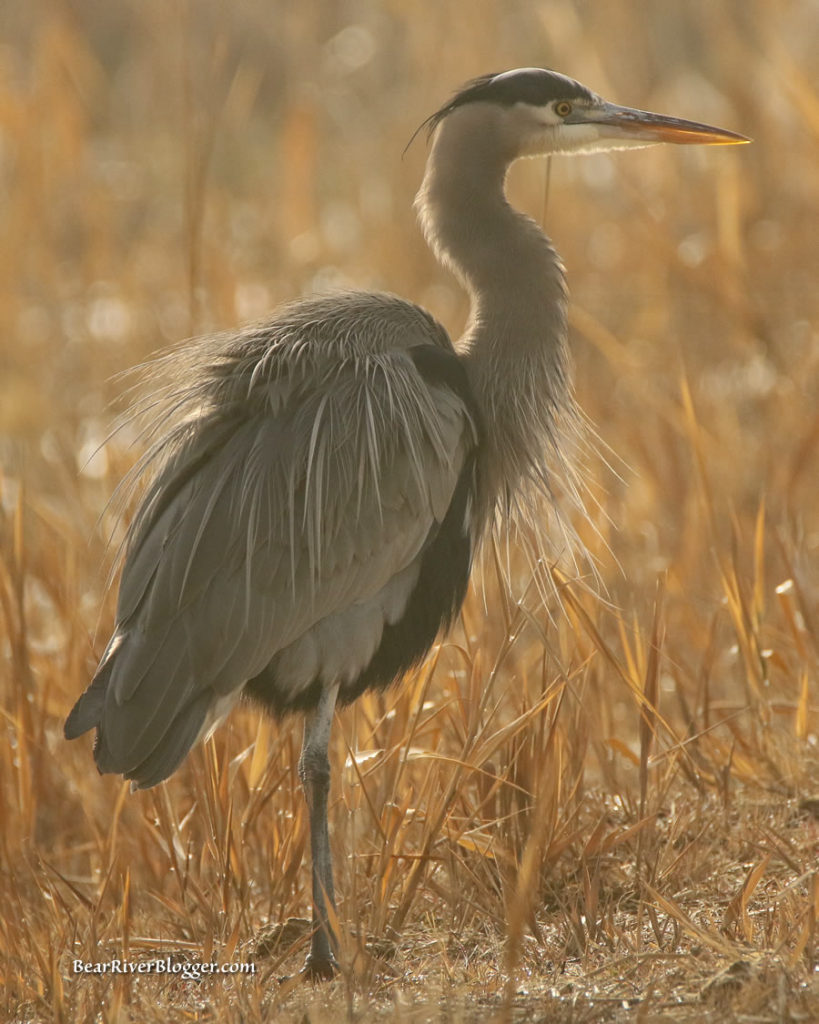
What Does The Great Blue Heron Eat?
I guess an easier question to answer is what doesn’t a great blue heron eat because they have such a varied diet. You can usually find them wading in shallow waters searching for fish and frogs but that is not all they will consume if fish are hard to find.
You can also find blue herons in grassy upland areas looking for snakes and mice. Typically the heron is a fish-eating bird and fish make up the majority of its diet when they are readily available, but great blue herons will search out all kinds of food from birds, rodents, insects, and snakes to turtles, salamanders, and frogs.
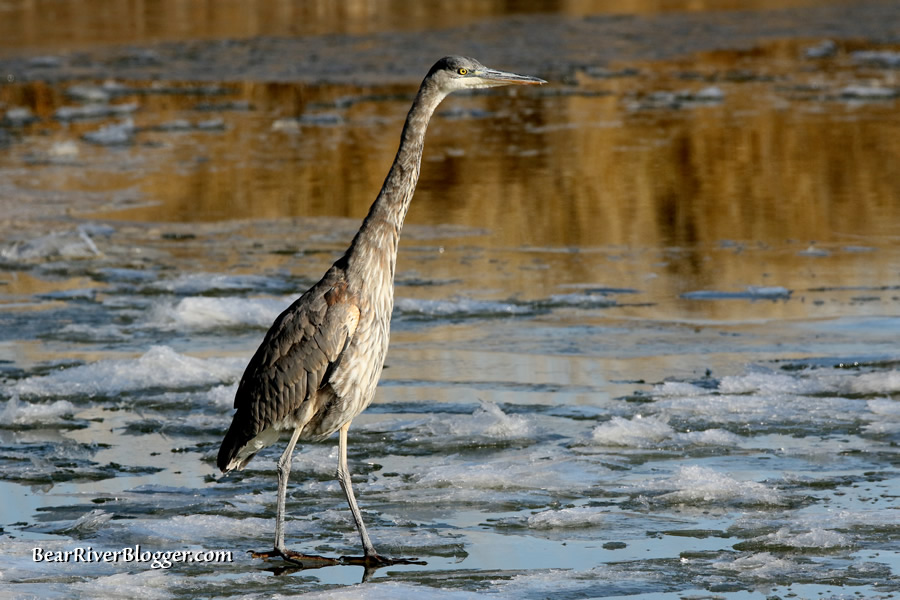
Do Great Blue Herons Migrate?
Depending on what region they are living in, great blue herons do migrate, if needed, and the further north they are, the more likely blue herons do migrate southward to find food when it becomes scarce because of extremely harsh winter conditions in more northern regions.
Northern populations of great blue herons, east of the Rockies, do sometimes migrate, with some heron going to the Caribbean, Central America, or the northern parts of South America. Great blue heron populations along the pacific coast don’t migrate and are thought of to be more permanent residents to their locales.
Great blue herons will migrate in these more northern regions when waters freeze and food sources become scarce. Availability of food is a primary factor for migration for not only the blue heron but for most migratory birds, in fact.
Great blue herons on the Bear River Migratory Bird Refuge are, in fact, a year-round resident. This doesn’t mean they never leave the refuge or migrate but only do so if weather conditions get so bad for so long they have to leave temporarily to find food. This, however, is not common, and the herons don’t stay away for long when it occurs.
I typically find the great blue heron all year long on the Bear River Refuge and have rarely seen conditions so harsh during winter none were found for a few weeks, giving me the notion they left the refuge to find food. But even during these brief and rare times of absence, the birds were quickly back on the refuge as soon as weather conditions improved.
For the most part, you can think of the great blue heron as a year-round bird for the Bear River Migratory Bird Refuge, and you can usually expect to see them during a trip to the bird refuge almost any time of the year.
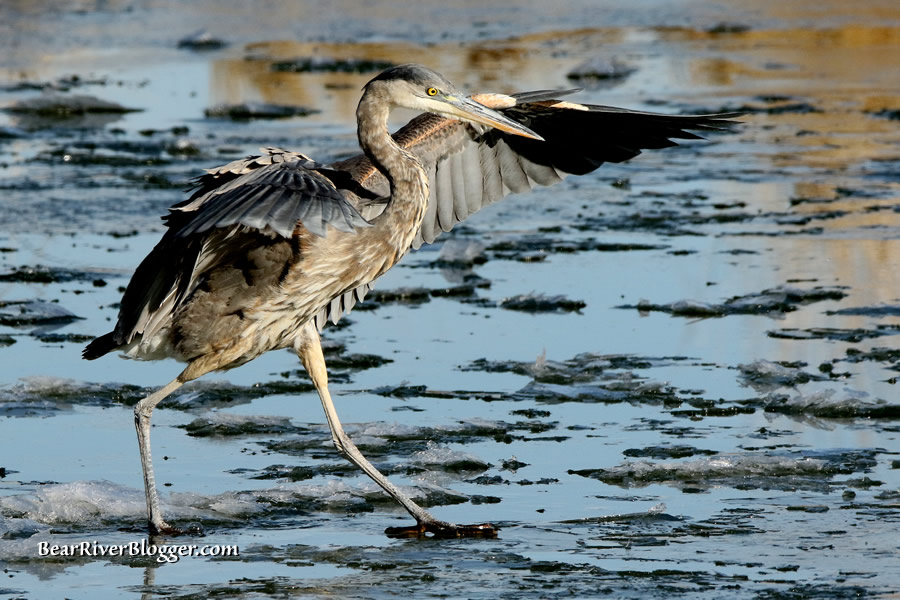
Where do Great Blue Herons Nest?
You have probably heard of the phrase “birds of a feather flock together”. This is especially true for breeding pairs of great blue herons. You can find herons nesting mainly in colonies with other herons or sometimes with other wading birds. They rarely nest alone in pairs.
Nest sites are highly variable for the great blue heron. You will most commonly find them nesting in trees 20-60 feet above the ground or water, but they can nest in low shrubs or even on the ground if no tall nesting opportunities exist.
For the Bear River Refuge, most if not all great blue herons nest on the ground due to the lack of trees or other tall structures.
Female herons are mainly the nest builders, with the males gathering the nesting materials for the large nests. Eggs can range from 2-7, and both parents take turns incubating the clutch as well as bringing back food to regurgitate for their hungry offspring.
Photographing the great blue heron on the Bear River Migratory Bird Refuge
If you’re interested in photographing great blue herons on the refuge, I would suggest you visit the refuge either morning or evening. I find most birds, including the heron, are more active and, as a result, easier to spot during these times of the day.
You will need to drive slowly around the auto tour route, watching on both sides of the road for stealthy herons perched alongside the roadside or canal in cattails or other vegetation. During summer months, they are commonly found in the shallow waters edge of the marsh and, for the patient observer, one can quite often photograph them during a successful hunt.
As far as gear goes, I have photographed them as close as 20 feet away and as far away as 50 yards or more. If you have multiple lenses, I would suggest bringing all you have because you never know just how close or far they will be. I photograph with a 600 mm lens, but I also have had a lot of success with a 300 mm lens because herons can be quite cooperative so a bigger lens isn’t always a necessity.
Set your camera for a fast shutter speed. When photographing birds, my target speed is around 1/2500 of a second so adjust your settings so you can achieve a fast shutter. This gives you the best opportunity to stop any unwanted movement, helping to sharpen the image if the bird takes to flight.
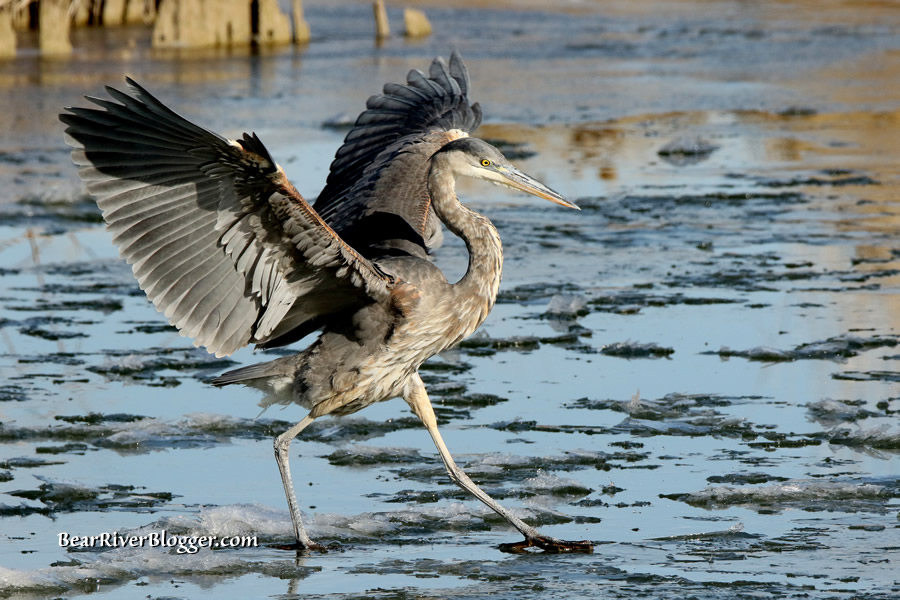
Visiting the Bear River Migratory Bird Refuge
If I have piqued your interest in the refuge, you should plan on several hours or more visiting the bird refuge. They have a great educational facility with a nature display, gift shop, and a nature walk. Contact the refuge for current hours for the educational center.
The self-guided auto tour route is open year-round, sunrise to sunset. From the educational center, it is 12 miles to the auto tour route, and the tour is another 12-mile gravel road making a full loop, so plan accordingly. It is a pretty remote area, so I always suggest bringing food, water, bug spray in the summer months, and a cell phone just in case of an emergency.

Contacting The Bear River Migratory Bird Refuge
The Bear River Migratory Bird Refuge headquarters is located just west of Brigham City, Utah. It is just west of Interstate 15 at the Forest Street exit.
I highly suggest contacting the Bear River Migratory Bird Refuge headquarters about current conditions on the refuge before any trip. Visit their website for more information about the refuge.
Headquarters Address:
2155 West Forest Street
Brigham City, Utah 84302
Phone: (435) 723-5887
Fax: (435) 723-8873
Email: bearriver@fws.gov

A Few Recent Great Blue Heron Images From The Bear River Migratory Bird Refuge
I recently spent a couple days on the Bear River Migratory Bird Refuge, watching and photographing great blue herons. I am intrigued when I see scenes of herons standing on ice, reminding me of my day’s ice fishing just up the road a bit.
Although great blue herons are a resident bird to the refuge, winter is my favorite time to watch and photograph them because of the winter-like scenes you can typically find this time of year.
The following images were all recently photographed on the refuge auto tour route. It is a great place to visit if you are a bird watcher, photographer, or, like me, both.
